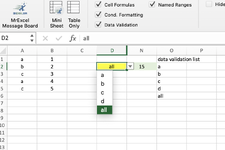Hello all you wise men & women,
After more than a decade away from this forum - you know, Life? - I managed to make my way back in after a long time of jogging my memory about my credentials. Man, Excel has evolved over the years...
Anyway, I have question for all you great people. I am trying to make a drop down menu with a "catch all values", or whatever you want to call it. Like:
Drop down items:
1. A
2. B
3. C
4. Sum of A, B & C
For 1., 2. & 3. I am fine, I used List. But, I can not get my head around 4. I managed to come up with a solution adding: '<>""' as the fourth item in the List. That appears to work and give me the outcome that I want, but in the drop down list it looks like, well: <>"" Do we agree that does not look very slick?
I am looking for something saying:"All Values", or "Total", or something like that while at the same time catching the sum of the other values combined.
How would you go about that?
Thank you very much in advance.
After more than a decade away from this forum - you know, Life? - I managed to make my way back in after a long time of jogging my memory about my credentials. Man, Excel has evolved over the years...
Anyway, I have question for all you great people. I am trying to make a drop down menu with a "catch all values", or whatever you want to call it. Like:
Drop down items:
1. A
2. B
3. C
4. Sum of A, B & C
For 1., 2. & 3. I am fine, I used List. But, I can not get my head around 4. I managed to come up with a solution adding: '<>""' as the fourth item in the List. That appears to work and give me the outcome that I want, but in the drop down list it looks like, well: <>"" Do we agree that does not look very slick?
I am looking for something saying:"All Values", or "Total", or something like that while at the same time catching the sum of the other values combined.
How would you go about that?
Thank you very much in advance.






